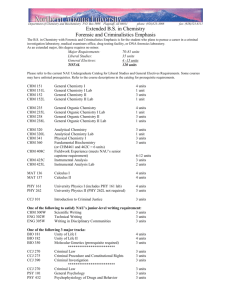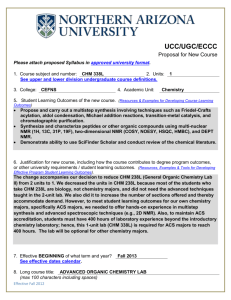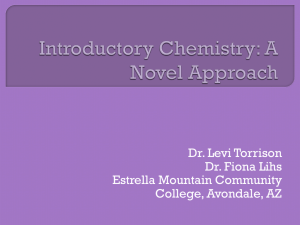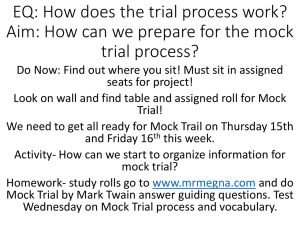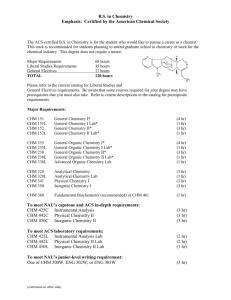2014_tri - Risk Management Services
advertisement
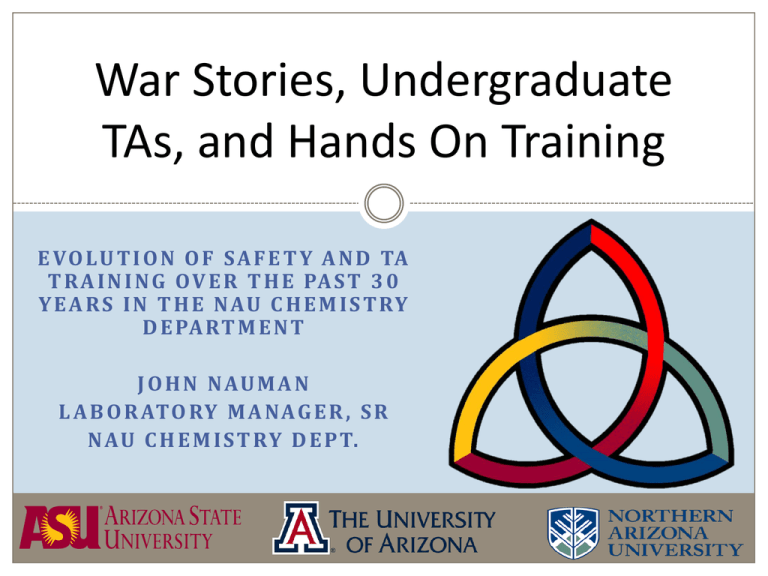
War Stories, Undergraduate TAs, and Hands On Training E VO L U T I O N O F S A F E T Y A N D TA T R A I N I N G OV E R T H E PA S T 3 0 Y E A R S I N T H E N AU C H E M I S T RY D E PA RT M E N T J O H N N AU M A N L A B O R ATO RY M A N A G E R , S R N AU C H E M I S T RY D E P T. Evolution of Laboratory Safety and TA Training History of NAU Chemistry Safety and TA Training at NAU – How do we differ from ASU and UofA? Current Course Design of “Laboratory Safety and Supervision” Weaving War Stories Into Lab Safety Training – Some Examples Hands on Aspects of Course: Laboratory Safety Audits, and Mock Emergency Training NAU Chemistry Department: 1981 Fall 1981 – My First Semester at NAU as 1st Lab Mgr. 15-20 Tenure Track Faculty who are Listed as Lab Instructors – TAs Never listed as Instructors. 4 Staff (1.5 Office, 1 Lab Mgr., 1 Stores, 0.5 Inst. Room) 2 GTAs 20-25 Undergraduate TAs and Stockroom Employees 20-30 Total Sections for all Lab Courses per Semester Very Limited State Operations and Student Wages Budgets that never really increased much in 15 years Risk Management Lab Safety – One Person in Facilities Nearly Everything in Chemistry Building NAU Chemistry Department: 2014 Fall 2014 – Now 3 Lab Mgrs. (2 added last five years) 15-20 Faculty Tenure Track, Lecturers, & 4 Lab Instructors 6 Staff (2 Office, 3 Lab Mgr., 1 Stores) 8-10 GTAs 40-50 Undergraduate TAs and Stockroom Employees ~100 Total Sections for all Lab Courses per Semester Most of Lab Program Funded by Lab Fees Including Salary for Undergraduate Employees not GTAs ~60-100 Chemistry Majors per Year In three different building: CHM, Wettaw, Sci. Lab, New! EH&S 6-7 Professionals How Have We Attempted to Make This Work? History of our Safety & TA Training Program: Annual Saturday Morning Safety Program (lecture and fire extinguisher training) 1-2 hour Spring Refresher on 1st Friday of Semester Incorporated Skits and Mock Emergencies into training sessions (involved 2-4 faculty) Created course CHM599 for undergraduate employees and graduate students. Course evolved to CHM 295 and 595, Laboratory Safety an Supervision, approved by curriculum committee early 90s. CHM 295 & 595 – Lab Safety and Supervision CHM 295 and 595 is offered for 1-2 units for undergraduates First unit is for safety training only Second unit is for TA training (All TAs in training take 2 units) Required for all students workers in labs (not research) Completion of organic chemistry is required for CHM 595 CHM 595 is a required course for all graduate students Often taken by students in our science teacher training program Mini Course Format: first 8 weeks of semester Use Risk Assessment Approach in Our Labs Safety Training Presentation format uses war stories, video tapes, group exercises, hands-on activities, EH&S training, and lecture Evaluation based on weekly quizzes, final, audit, and completion of Mock Emergency Training (CPR xtra) Texts used include “Safety in Academic Chemistry Laboratories” , “NAU Chemistry Department Chemical Hygiene Plan”, and a reading packet. Objectives: Familiarity with lab safety concepts, emergency response, references, department & NAU policy and meet OSHA training requirements. TA Training Some Common Training Done for All TAs - Changing Upper Division Labs 1-2 TAs Mostly Graduate Students Trained Mainly by Faculty Instructor for Lab For General and Organic Chemistry Labs (multiple sections) TAs are required: Shadow a Lab Section before their section or the semester before Attend All Required TA Meetings Complete a Weekly Workbook Course Schedule First week: EH&S Chemical Hygiene Training, Essential Lab Safety and Emergency Response Week 2: Hazard Codes, Labels, SDS, Group Exercise Weeks 3-5 Fire Safety, Chemical and Hazardous Waste Management, Toxicology, Lab Procedures, Laboratory Safety Audit Week 6: Mock Emergency Training Week 7: Special Lab Hazards and Procedures Week 8: Safety and TA Finals Group Formation Groups of 4-6 students Composition of groups is based on chemistry background and Personality Groups work together throughout the course Standard Lab Safety Class Format Hand back and go over quiz from previous week Nearly Every quiz with have Emergency Response and Prevention question applying war story. Short Lecture over topic(s) Group work applying to lecture focus Video, tour to see safety stuff or more lecture Quiz Example War Stories and Lessons My Stupid Run In With Sulfuric Acid and Lessons Learned Sodium Amide Incident Nitric Acid and Ethanol Explosion and Hazardous Waste Collection Methyl Methacrylate Explosion and Chemical Storage Breaking 2.5L Bottles of Conc. HCl and Transporting Chemicals Recent – Nitrile Glove Incident(s) Laboratory Safety Audit Each student conducts audit If possible students check areas where they work Chemical inventory is done as part of audit 10% of student’s grade is base on audit Resulting audit and inventory very useful Mock Emergency Training Mock emergencies are setup and run by past students in the course, faculty and staff, risk management staff, and campus security Student groups rotate through 4-6 emergency scenarios over 2-3 hour period. Each scenario is as real as possible to allow students to practice their emergency response skills Scenarios also allow for participants to review causes and prevention of lab emergencies Schedule for Each Scenario Organize in lecture room Walk to scene Assess scene (5-10 sec.): safe to help, scope of problem Initial Response (30 seconds): evacuate lab, put out fire, notify security, evacuate building, CPR, first aid Manage Scene (up to 5 minutes): witnesses, EMS, MSDS, scene control, TLC Scenario ends and group look for causes and prevention Critic by victims and observers, do participant notes Return to lecture room Participant Roles for Mock Emergency Training Class Responding Groups Students, Faculty and Staff Team leader Person to notify campus Victims – folks simulating security (EMS) Observer – fills out “Record of Safety Incidence” Other group members Each group member must rotate through each of the roles above injuries or conditions of some sort. Bystanders – folks who scream or just confuse the scene. Observers – people not part of the scene who evaluate the response of each group Scenarios Chemical Contact Fire Peroxide Explosion Toxic Chemical Spill Stroke or Heart Attack Seizure Schedule of Scenarios Times 6-6:30 6:30-7 7-7:30 7:30-8 8-8:30 404 1 2 3 4 Debrief 418 2 3 4 1 303 3 4 1 2 326 4 1 2 3 Mock Emergency Training Objectives Provide hands-on experience for class members Fun review of safety for student employees who have taken the course Provide safety training for faculty and staff Heighten general safety awareness in department Foster cooperation between our department, risk management, and campus security Buy in and focus on lab safety (video example) Thanks to: Faculty and staff of our chemistry department Past class members and student employees EH&S Staff Facilities Staff for doing CPR-AED training Questions?

